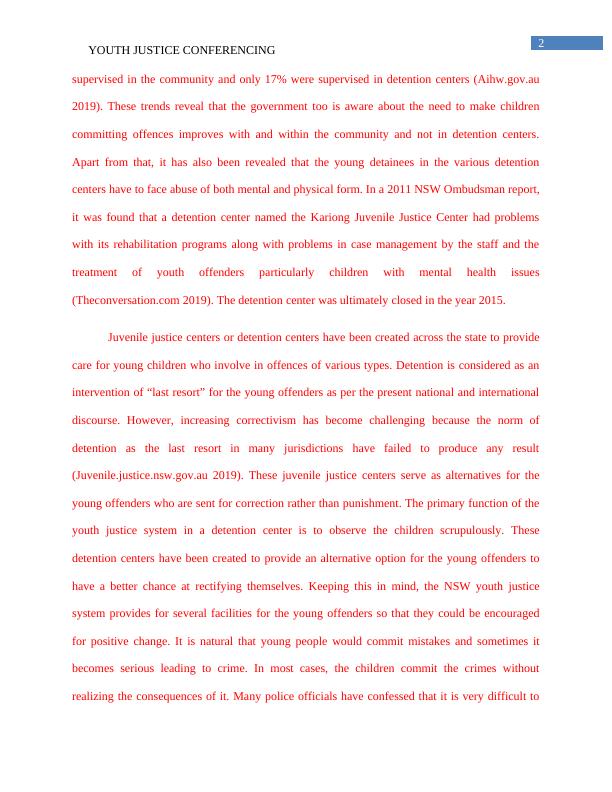Youth Justice Conferencing
Added on 2022-10-19
8 Pages1979 Words469 Views
Running head: YOUTH JUSTICE CONFERENCING
YOUTH JUSTICE CONFERENCING
Name of the student
Name of the university
Author note
YOUTH JUSTICE CONFERENCING
Name of the student
Name of the university
Author note

1
YOUTH JUSTICE CONFERENCING
Introduction
The purpose of this assignment is to shed light on the proposal that suggests allocation of
25 million dollars from the state funds for the establishment of a new youth detention center. The
assignment will provide an analysis of the proposal and support thee NSW Parliament in taking
the final decision on building a new detention center by allocating 25 million dollars. The
primary purpose of youth detention centers is to provide a better place for youth offenders for
correcting their behaviors rather than sending them to prison. However, as experts have pointed
out, “youth custody in whatever form, is that it is self-defeating and counterproductive”. The
assignment thus aims to argue that the allocating further 25 million dollars for the building of a
new youth detention center using State Funds must be rejected. The main reason for this is
because NSW already has a number of youth detention centers and it is important to focus on
these and improving their infrastructure rather than building a new one.
Background
The juvenile justice system serves as the framework for several practices that could assist
the young people who are supposedly engaged in different forms of offences to lead an improved
life. The juvenile justice system in the NSW region majorly deals with the children belonging to
the age group of 10 to 17 years when the crime is being committed. For any youth justice system,
the youth justice supervision is a major feature involving young people. The young people might
be supervised either in the community or in safe detention facilities. According to the latest
reports by the Australian Institute of Health and Welfare or AIHW, the rate of young children
under supervision on per day average has been the highest in the community and lowest in
detention centers. The report found that around 83% of the young offenders have been
YOUTH JUSTICE CONFERENCING
Introduction
The purpose of this assignment is to shed light on the proposal that suggests allocation of
25 million dollars from the state funds for the establishment of a new youth detention center. The
assignment will provide an analysis of the proposal and support thee NSW Parliament in taking
the final decision on building a new detention center by allocating 25 million dollars. The
primary purpose of youth detention centers is to provide a better place for youth offenders for
correcting their behaviors rather than sending them to prison. However, as experts have pointed
out, “youth custody in whatever form, is that it is self-defeating and counterproductive”. The
assignment thus aims to argue that the allocating further 25 million dollars for the building of a
new youth detention center using State Funds must be rejected. The main reason for this is
because NSW already has a number of youth detention centers and it is important to focus on
these and improving their infrastructure rather than building a new one.
Background
The juvenile justice system serves as the framework for several practices that could assist
the young people who are supposedly engaged in different forms of offences to lead an improved
life. The juvenile justice system in the NSW region majorly deals with the children belonging to
the age group of 10 to 17 years when the crime is being committed. For any youth justice system,
the youth justice supervision is a major feature involving young people. The young people might
be supervised either in the community or in safe detention facilities. According to the latest
reports by the Australian Institute of Health and Welfare or AIHW, the rate of young children
under supervision on per day average has been the highest in the community and lowest in
detention centers. The report found that around 83% of the young offenders have been

2
YOUTH JUSTICE CONFERENCING
supervised in the community and only 17% were supervised in detention centers (Aihw.gov.au
2019). These trends reveal that the government too is aware about the need to make children
committing offences improves with and within the community and not in detention centers.
Apart from that, it has also been revealed that the young detainees in the various detention
centers have to face abuse of both mental and physical form. In a 2011 NSW Ombudsman report,
it was found that a detention center named the Kariong Juvenile Justice Center had problems
with its rehabilitation programs along with problems in case management by the staff and the
treatment of youth offenders particularly children with mental health issues
(Theconversation.com 2019). The detention center was ultimately closed in the year 2015.
Juvenile justice centers or detention centers have been created across the state to provide
care for young children who involve in offences of various types. Detention is considered as an
intervention of “last resort” for the young offenders as per the present national and international
discourse. However, increasing correctivism has become challenging because the norm of
detention as the last resort in many jurisdictions have failed to produce any result
(Juvenile.justice.nsw.gov.au 2019). These juvenile justice centers serve as alternatives for the
young offenders who are sent for correction rather than punishment. The primary function of the
youth justice system in a detention center is to observe the children scrupulously. These
detention centers have been created to provide an alternative option for the young offenders to
have a better chance at rectifying themselves. Keeping this in mind, the NSW youth justice
system provides for several facilities for the young offenders so that they could be encouraged
for positive change. It is natural that young people would commit mistakes and sometimes it
becomes serious leading to crime. In most cases, the children commit the crimes without
realizing the consequences of it. Many police officials have confessed that it is very difficult to
YOUTH JUSTICE CONFERENCING
supervised in the community and only 17% were supervised in detention centers (Aihw.gov.au
2019). These trends reveal that the government too is aware about the need to make children
committing offences improves with and within the community and not in detention centers.
Apart from that, it has also been revealed that the young detainees in the various detention
centers have to face abuse of both mental and physical form. In a 2011 NSW Ombudsman report,
it was found that a detention center named the Kariong Juvenile Justice Center had problems
with its rehabilitation programs along with problems in case management by the staff and the
treatment of youth offenders particularly children with mental health issues
(Theconversation.com 2019). The detention center was ultimately closed in the year 2015.
Juvenile justice centers or detention centers have been created across the state to provide
care for young children who involve in offences of various types. Detention is considered as an
intervention of “last resort” for the young offenders as per the present national and international
discourse. However, increasing correctivism has become challenging because the norm of
detention as the last resort in many jurisdictions have failed to produce any result
(Juvenile.justice.nsw.gov.au 2019). These juvenile justice centers serve as alternatives for the
young offenders who are sent for correction rather than punishment. The primary function of the
youth justice system in a detention center is to observe the children scrupulously. These
detention centers have been created to provide an alternative option for the young offenders to
have a better chance at rectifying themselves. Keeping this in mind, the NSW youth justice
system provides for several facilities for the young offenders so that they could be encouraged
for positive change. It is natural that young people would commit mistakes and sometimes it
becomes serious leading to crime. In most cases, the children commit the crimes without
realizing the consequences of it. Many police officials have confessed that it is very difficult to

End of preview
Want to access all the pages? Upload your documents or become a member.
Related Documents
Challenges Faced by Detention Centres in NSWlg...
|8
|1846
|89
Allocating $25 Million for Youth Detention Center Proposallg...
|7
|2082
|91
LEGL3008 Child Law - Child Abuse In Youth Detention Centerslg...
|4
|1251
|58